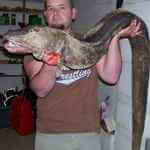 The conger is often seen as a bit of a bogeyman underwater, leaving divers fearful of holes under ledges or in wrecks where a conger may lurk. In reality, conger are not aggressive fish, so you have little to fear if you’re just searching for bass or lobsters in holes. They will back away from you usually.
The conger is often seen as a bit of a bogeyman underwater, leaving divers fearful of holes under ledges or in wrecks where a conger may lurk. In reality, conger are not aggressive fish, so you have little to fear if you’re just searching for bass or lobsters in holes. They will back away from you usually.
On the other hand, if you are specifically hunting for conger, it can be a different story. They will definitely try to bite you if speared, and landing them takes a bit of care and a few tricks. Follow our tips to learn how to land your first conger.
Minimum size
91cm/36in (correct for 2020)
When is best to hunt for conger?
Conger are resident in holes all year round. Good catches can be made in January and February when there is little else around.
Where is best to catch conger?
Everywhere there are rock reefs, wrecks and holes, there are congers. They love breakwaters, caves and structures. Wrecks are certainly the best places to look for them. Depths 2m – 20m+
Behaviour and hunting:
Occasionally you will see a conger swimming free as it hunts. This is often when you are lying in wait for other species on the bottom. They are not shy and will not usually react to you. Far more frequently they will be seen in a hole or crevice. You will see the head peering out and should usually shoot at the head immediately. They tend to become shy if you take your time looking at them and will often retreat into their cave.
Whilst finding and hitting them does not prove to be a problem, they can be quite problematic once shot.
Tips:
- Shoot the conger through the head
- Immediately grab the line and pull the conger out of the hole, give it no slack or it will dig in and not be shifted!
- Be prepared that your spear is likely to be bent beyond use by a large one
- Be aware that the conger will try to spin on the line and tie itself up with such force that your leader is likely to need replacing
- Be aware that you should keep clear of the head and not try to grab the head as it will bite you!
- Be aware it does not have a convenient gill case to grab
- Be aware they are very slimy and impossible to grip, hence with anything but a head shot you are likely to be bitten
- Remove the conger from the water as quickly as possible, onto the boat or shore where it is easier to kill
- If you have a buddy they can put in a second shot to kill it for you
- All in all they are troublesome fish and we usually leave them alone. However they do make good eating and for a diver looking for a struggle with a big fish – they are about as big as it gets in the UK! They also offer the chance of something to catch during the winter months.
- A slip tip makes landing them far easier if you are specifically hunting them.
Dive report
“Carefully swimming along the crack I saw a huge conger tail side on. it was not possible to see the head which was within the structure, only the end of the tail was visible. I took aim with my Rob Allen 80cm fitted with a slip tip and fired at the tail. All at once there was a huge commotion as the sand was blown everywhere and I swam full speed back along the bottom, pulling the line as hard as I could to get the conger clear of the crack before it could dig in. Pulling a very angry 60lb conger to the surface (fortunately only in 4m water) was tricky as it swung around trying to get purchase on something- or me. The slip tip was impossible to shake. I Decided to kill it on the boat so jumped back into my little 3.4m inflatable and hauled the angry conger on board. At this point my two dive buddies jumped out of the boat…”
Eating:
5/10 decent cut as steaks and grilled with lemon juice. Also good in fish stew. Use only the front 2/3 of the fish as the tail is too bony but makes good fish stock.
Weapon of choice:
Rob Allen 80 Carbon with 20mm rubbers and 7mm spear- with slip tip.

